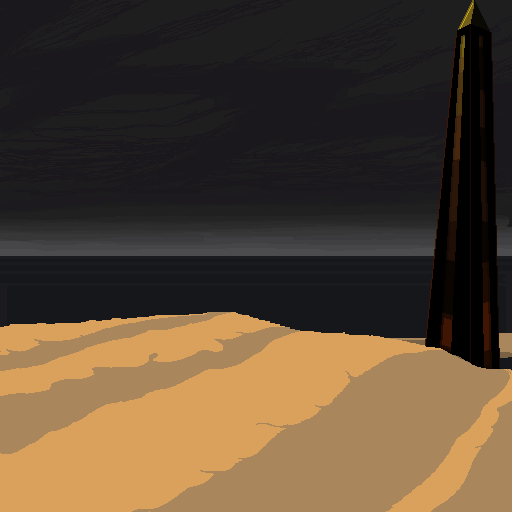On Reagan Library
Created: 2023-04-01 (12:00:00) — Modified: 2025-06-27 (20:20:04)Status: in progress
Stuart Moulthrop’s Reagan Library should not have fallen into such a state of deep unplayability so quickly. This not-quite-game but also not-quite-cybertext sees you clicking through brief, apparently disconnected text fragments. When you start out, they are all jumbled together, filled with vacancies and interference. It is difficult to draw out any coherence from them. For instance, your first visit to the ruins reads like this:
“I awoke one inky midnight in the library. It was not what I expected, but here I was, poured out on the blank sands, my conviction duly registered, sentence indefinite.
“Fuzzy little world. Catachresis five… Ergodics for the masses… Mmm, Mmm, Gutenberg… Remembering the biological father of our country… Had this been a virtual emergency… Like putting out more noise to blight our fates…”
Only as you follow those links, seeming to move between both different physical spaces like the white cone and the library, as well as different points in time, do the fragments slowly begin to cohere. After enough traversals they will be whole again, and you can read them in their original form. On a later (but not final) visit, this is what the ruins text looks like:
“I awoke one inky midnight in the library. It was not what I expected, but here I was, poured out on the blank sands, my conviction duly registered, sentence indefinite. They wrote me up for oral infractions, did me for whistling out of tune, sent me down on a charge of vagary… or something like that.”
Other fragments, though, disintegrate as you traverse them. By the time everything else coheres, the initial waymarkers of your reading have themselves fallen into illegibility.

At each fragment the game shows you a navigable panorama, seen from the place and time you are crossing though. Everything takes place in an eerie archipelago littered with ruins and monuments, beaches and walls of flame. As an alternative to clicking through links, you originally had the option of scanning through these panoramas, and clicking across to nearby features, which not only moved you through the virtual space, but propelled you into another point in time, another state of this world too. You may set out for the monument on the nearby island, framed against blue sea and sky, only to arrive at its remnants, the sea gone black and the sky turned red.
This is how the Reagan Library is supposed to work. A straightforward combination of pages, some javascript to track the game state, and panoramas implemented in QuickTime VR. Only, twenty-five years after its release, the html and javascript implementations used by browsers have moved on. The links no longer ferry you from worldstate to worldstate as reliably as they once might have.
And QuickTime panoramas as a format are long dead. The only way to view them now is to download each individual movie file and open it in a separate program, Videopanoramas Player. You can gaze out over this ruined landscape but no longer traverse it visually. It is easy to get stuck looping through the same few text fragments, unable to proceed further, whereas originally you could have simply set out for another landmark in view.
For something that probes death, disintegration, entropy and memory in this way, there is something darkly fitting in the way Reagan Library itself has unravelled. Two decades of shifting software standards have stranded it, like one of its own eroded monuments.
See also
References
- Moulthrop, Stuart, 1999, Reagan Library, online
- Youssef, David, 2008, “Electronic Ruins: Virtual Landscapes Out of History,” Electronic Literature: New Horizons for the Literary, online
Endmatter
Tags: @archival @cybertexts @in-progress @virtual-spaces
Return to: Ormulum